

SOUTH BAY WATCH
SOUTH BAY CITIES COUNCIL OF GOVERNMENTS
A Greener South Bay A Greener South Bay
MEASURING THE SOUTH BAY’S CARBON FOOTPRINT
Report Reveals
40.7% Drop in the South Bay’s CO2 Emissions Compared to 2005
See Page 2
IN THIS ISSUE
PAGE 4
The SBCCOG’s Founding Leader is Honored for Influence and Helping South Bay’s Older Adults
PAGE 6
The SBCCOG Receives State Nod for Cataloging Energy -Using Equipment in Municipal Buildings
PAGE 6
South Bay Elementary Students Are Rewarded for Their Families’ Energy-Saving Efforts
PAGE 7
L.A. County Registrar/ Recorder/Clerk Discusses Ballot Safety and Integrity
PAGE 8
Toro CARE Enables Food-Insecure CSUDH Students to Focus on School Instead of Hunger
The Road to Net Zero
Study Shows 40.7% Drop in South Bay Greenhouse Gas Emissions
Compared to 2005
David Hines likes data. And it’s a good thing since he has spent nearly a year as the CivicSpark fellow for the South Bay Cities Council of Governments (SBCCOG) collecting and analyzing greenhouse gas (GHG) emissions figures for the entire South Bay subregion. The end game is to determine if cities have met goals established in the South Bay Climate Action Plan (CAP), developed and approved by the SBCCOG in 2018.
“How dramatic the reductions were in emissions across all of our cities is staggering,” Hines said. “There have been significant reductions, especially in buildings. Energy and gas use for commercial, residential and industrial facilities have substantially decreased.”
THE PLAN FOR REDUCING GHG EMISSIONS
Following heightened concern at the state and federal levels of the growing effects of climate change, in 2006 the state passed Assembly Bill 32, requiring California to reduce overall GHG emissions to 1990 levels by 2020 and to 40% below 1990 levels by 2030. This served as the impetus for the SBCCOG to work with its 15 member cities to complete GHG inventories for 2005 and 2007, paid for by a special assessment.
SBCCOG staff collected and entered the figures using the ClearPath tool (icleiusa.org/ clearpath) from ICLEI – Local Government for Sustainability, which converts statistics into emissions data based on industry standard protocols. Updates were conducted for 2011 and 2012, funded by Southern California Edison (SCE) and SoCalGas. Using a 2005 baseline carbon footprint, the SBCCOG then worked with individual cities to develop CAPs to help them set goals and adopt strategies for reducing their GHGs and then developed a subregional CAP for the entire South Bay.
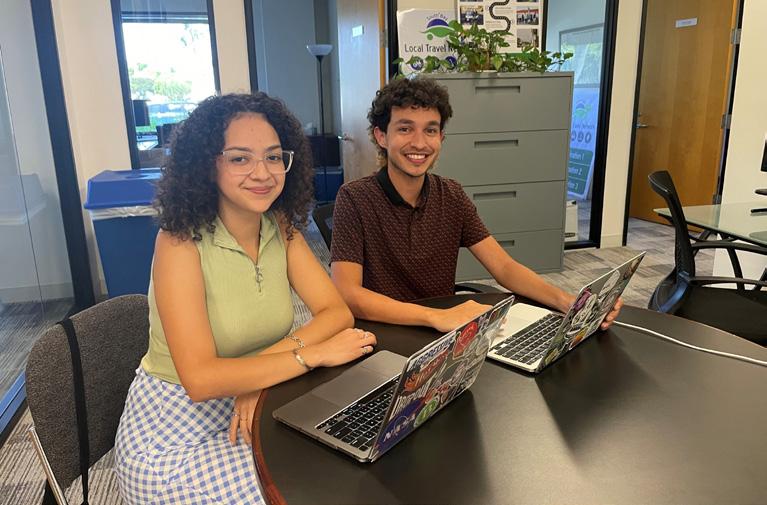
GHG GOALS AND FINDINGS
The goals established by the South Bay CAP were two-fold: 1) reduce emissions by 15% of 2005 levels by 2020 and 2) reduce emissions to 49% of 2005 levels by 2035. Hines’ findings, presented to the SBCCOG in July, reveal that the South Bay has cleared the first goal and is within short reach of the second. The new data will be used to update the South Bay CAP and its progress in attaining a netzero carbon footprint.
Source: bit.ly/GreenhouseGasEquivalencies
Hines analyzed the GHG data in six emission sectors: transportation, residential, commercial, waste, wastewater and fugitive (leaks or other irregular releases of gases or vapors from appliances or other equipment). While the emissions goal year was based on reductions from 2005 to 2020, due to COVID-19, 2020 was an atypical year, so 2019 data was used. During that span commercial energy had the most significant drop—down 64.8% from 2005 to 2019. Transportation—the
largest emissions sector—had a reduction of 16.9% from 2005 to 2019. The annual reductions are equal to the preservation of 3.7 million acres of forest (about the size of Connecticut).
HOW CITIES REDUCED THEIR GHGS
The report attributes the reductions to three main factors: 1) adoption of renewable energy (energy powered by sources like solar,
David Hines (right), one of the SBCCOG’s CivicSpark fellows, and SBCCOG intern Angela Delgado, studied greenhouse gas data collected from South Bay cities. Delgado is majoring in physics and environmental studies at Bowdin College. Delgado’s internship is funded by an undergraduate research grant.
wind or hydroelectric power, etc.), 2) energy efficiency (improving building insulation, transitioning to LED lights and advancements made in energy-efficient appliances) and 3) electric vehicle adoption.
“Because the state has implemented laws to regulate transportation and energy use, the state has a cleaner electric vehicle fleet mix. Utilities must also provide more renewable energy generation, instead of buying coal from out of state for example,” said Kim Fuentes, deputy executive director of the SBCCOG. “Because of those two factors we’ve seen huge reductions in GHGs over the last seven years, since our last inventory was completed.”
SCE renewable energy use totals jumped from 17% in 2005 to 35.1% in 2019. In California, electric vehicle sales went from practically nonexistent in 2005 to more than 200,000 in 2020, making up more than 10% of new car purchases.
Additionally in recent years, cities including Carson, Hawthorne, Hermosa Beach, Manhattan Beach, Redondo Beach and Rolling Hills Estates have joined the Clean Power Alliance (CPA), a community choice aggregator (CCA). A CCA allows local government to procure cleaner power for its community. Through CPA membership, depending on the chosen plan, up to 100% clean power can be purchased by member cities through SCE. Residents of CPA cities are automatically opted in unless they choose to opt out.
As an example, Hermosa Beach signed on to CPA’s 100% plan. The city also took additional steps toward energy net zero, such as replacing one-third of the city’s government cars with electric vehicles, adding solar roof panels to municipal buildings including the Hermosa Beach Community Center, and converting SCE streetlights to LEDs. It will convert its historic Clark Building from gas to electricity later this year, which will bring the city closer to its 2035 goal.
TAKING IT A STEP FURTHER
Since the South Bay CAP adoption, the SBCCOG has worked to implement the plan’s strategies by leveraging partnerships to obtain funding for programs, such as energy
equipment upgrades for municipal facilities, residents, businesses and community members. One such partnership is with the Southern California Regional Energy Network (SoCalREN) which promotes energy efficiency in public agencies. Through the SoCalREN, the SBCCOG has employed the help of CivicSpark fellows to catalog energy-using equipment at municipal buildings to identify additional energy-saving opportunities and resources to implement recommended changes.
“This is very tedious work and requires expertise that we just don’t have,” said Doug Krauss, environmental programs manager for the City of Hermosa Beach. “Without this program we would have to hire consultants, so we are very grateful to the SBCCOG for conducting this exercise.”
In partnership with the SoCalREN, last year the SBCCOG launched the first annual
South Bay Energy and Climate Recognition Program, which enables cities to earn bronze, silver and gold status, based on actions they take to become more sustainable.
“All of these steps are pushing us further and further toward reduced emissions,” said Fuentes.
Hines, a recent graduate of Northwestern University, with a Bachelor of Science degree in civil engineering, picked up the three-year GHG inventory project where the SBCCOG’s previous CivicSpark fellows— Anne Youngdahl followed by Lauren Estrella—had left off.
CivicSpark is an AmeriCorps program dedicated to building the capacity of local governments and communities to address emerging environmental and social equity resilience challenges, such as climate change. During their 11-month service year, CivicSpark fellows complete research, planning or implementation of projects that provide the support public agencies need to advance their resilience initiatives.
“Fellows really are the future for achieving sustainable communities,” said Fuentes. “Without their contributions, this critical work simply would not be possible.”
With Hines’ fellowship ending, he hopes to continue to employ the skills he has gained in emissions reporting as he enters the workforce. •
To learn more about the SBCCOG’s climate action planning work, visit southbaycities. org/sustainable-south-bay/#climate.
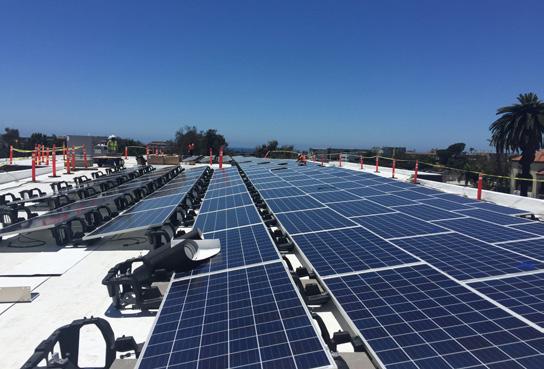
To reduce greenhouse gas emissions, Hermosa Beach has added solar roof panels to municipal buildings, such as the Hermosa Beach Community Center.
The SBCCOG’s 26-Year Leader Recognized for Advancing Quality of Life in the South Bay and for Older Adults
Jacki Bacharach was rummaging through the garage of her Rancho Palos Verdes home and found a copy of a letter she had written to her junior high school principal. It offered a list of suggestions for how to make the school a better place. Although she doesn’t remember if the suggestions were implemented, the letter inspired her to run for student council.
She ran every semester during junior high and high school— never winning a single election. But in the face of defeat, she remained undeterred.
“Some kids might say, ‘Oh, they didn’t vote for me, I’m not going to run anymore,’ but I remember not feeling defeated and instead thinking, ‘I have all these ideas, and they are not taking advantage of them,’” Bacharach said.
Her interest in making things better led her to study the inner workings of government as a political science major at UCLA, where at a party she met her future husband—an aerospace engineer at South Bay aerospace firm TRW. The love-at-first-sight union led to their wedding five months later.
After graduation Bacharach worked for two years as a social worker for the Los Angeles County Department of Public Social Services until she had her first child. Her growing family then moved to Palos Verdes, where over the years she served as
president of the League of Women Voters, the Palos Verdes Peninsula Coordinating Council and the Friends of the Library. She was also appointed to the Rancho Palos Verdes Planning Commission.
In 1980 voters finally took notice of her ideas. They elected Bacharach to the Rancho Palos Verdes City Council, where she served for 14 years—four of them as mayor. Her council role led to her involvement in the South Bay Cities Association, where she eventually served as president, and a 12-year appointment on the Los Angeles County Transportation Commission, the region’s primary transportation planning arm until the Metropolitan Transportation Authority (Metro) was formed in 1993.
“Transportation is something everybody uses, especially seniors, so it was a good nonpartisan issue to get involved in. At the time no one was focusing on rail, so I became chair of the rail committees. It was like getting a PhD in rail,” she said. In May 2023, Metro reported that 3.3 million monthly senior ridership fares were collected.
Bacharach served as chair of the commission’s Planning and Rail Construction Committees and eventually the entire commission. As chair, she led the development of the overall rail plan for Los Angeles County and oversaw the construction of the Metro Blue Line and Green Line.
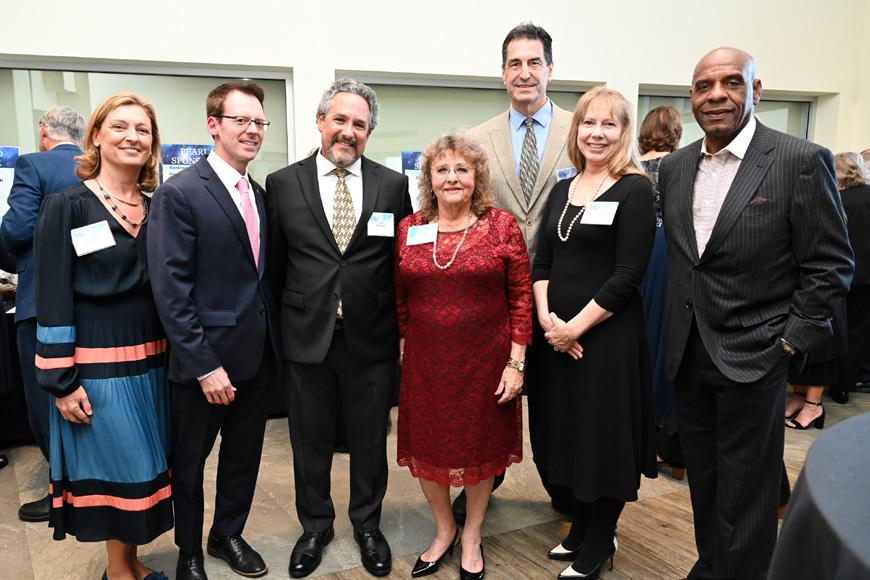
From left: Attending the recent Starry Night Harbour Lights gala, which benefited Helping Elders Live Productively (H.E.L.P.), are Frederique Bacharach, Jacki Bacharach’s daughterin-law; Scott Houston, board member, West Basin Water District; Larry Bacharach, Jacki’s son; Jacki Bacharach, executive director, SBCCOG; Omar Fuentes; Kim Fuentes, deputy executive director, SBCCOG; Steven Bradford, California Senate member, 35th District.
“Jacki’s vision, creativity and leadership ability have made her the leader of many great projects in the South Bay, even before the South Bay Cities Council of Governments.”
During her time in public office she became founding chair of The Southern California Regional Rail Authority (Metrolink), and founding vice chair of the Los Angeles–San Diego–San Luis Obispo Rail Corridor Agency, which oversees improvement to LA-San Diego Amtrak service. She served in numerous other high-profile transportation roles as well, including an appointment to the National Commission on Intermodal Transportation by Federico Peña, the U.S. Secretary of Transportation at the time.
After 14 years Bacharach left public office and tried transportation consulting. But she soon began to feel that familiar nudge that her ideas weren’t being put to use.
“I was getting all these jobs, but what they really wanted was my name. It was not fulfilling because I really wanted to do things and not just get paid to have my name used,” she said.
In 1994 the South Bay Cities Association formally became a council of governments and a joint powers authority. Four years later, the Southern California Association of Governments agreed to fund one year for the executive director of the South Bay Cities Council of Governments (SBCCOG). At that time, the SBCCOG was administered by the City of Torrance. Bacharach accepted an offer to lead the organization.
Cities soon recognized the organization’s value and agreed to pay their own dues. After that, the organization took off.
Through the SBCCOG, the 15 South Bay cities, City of Los Angeles and Los Angeles County have worked together for nearly 30 years to develop programs to address a variety of issues impacting the subregion.
Its transportation and land use program manages Measure R and Measure M Subregional Transportation Funds. It also created the Local Travel Network, a network of streets to promote the safer use of zero-emission, lightweight vehicles, such as e-bikes. The SBCCOG has developed environmental programs with utility providers to promote energy and water conservation through the South Bay Environmental Services Center. Through its technology program the SBCCOG is working to bridge the digital divide through the creation of a low-cost municipal broadband network called the South Bay Fiber Network. The SBCCOG also advocates for the interests of the subregion by monitoring and coordinating responses and positions on legislation that impacts the South Bay.
The SBCCOG also created a Social, Welfare, Equity and Access program to develop effective strategies for preventing homelessness. The program also supports awareness among cities of various programs that serve the community’s older adults to promote an age-friendly South Bay. Focus areas include mobility, wellness and housing strategies.
Through a study called the Digital Equity Project, the SBCCOG plans to identify community needs and expand parts of its South Bay Fiber Network to bolster broadband access in underserved areas. This will benefit older adult populations, who are sometimes without internet access and can suffer from greater social isolation and disconnection from telehealth services, disaster preparedness and other opportunities.
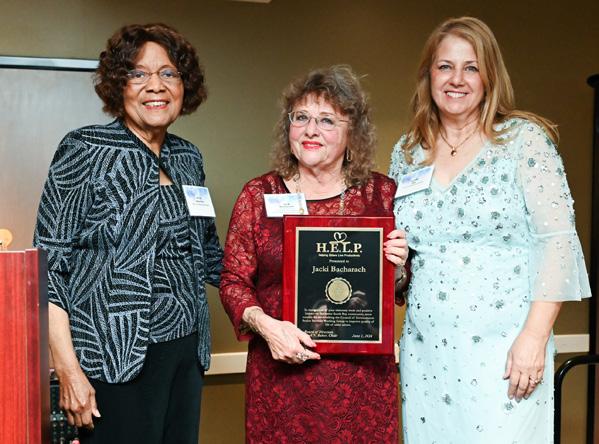
Jacki Bacharach, SBCCOG executive director, receives the Inspiration Award for her work helping the South Bay’s older adult population. From left: Olivia Valentine, SBCCOG 2020–2021 chair and former Hawthorne Council member; Bacharach; and Connie Hay, executive director, H.E.L.P.
Although her ideas may not have drawn attention during her early life, Bacharach’s more than five decades of service with the SBCCOG and the community have not gone unnoticed. In June the South Bay nonprofit Helping Elders Live Productively (H.E.L.P.) honored Bacharach with its 2024 Inspiration Award, following a nomination by Olivia Valentine, former Hawthorne council member and SBCCOG chair.
The Senior Services Working Group has been meeting for 10 years to advance these goals. Among its accomplishments are introducing cities and community members to resources, such as the Palos Verdes Peninsula and South Bay Villages, 501(c)3 nonprofit organizations that help older adults in South Bay communities stay in their homes with the help of volunteers.
“Jacki’s vision, creativity and leadership ability have made her the leader of many great projects in the South Bay, even before the South Bay Cities Council of Governments,” said Valentine. “It’s about her unique talent to become aware of a problem that needs solving, to envision how that problem can be solved, to do the research to justify moving forward, and then to know how to mobilize support for that project, from community leaders to local and state legislators.”
Bacharach shows no sign of slowing down. “It’s so much fun working intergenerationally,” she said of working with colleagues that span from Gen Z to baby boomers. “It’s really hard to stop because I love all these issues, and I do love being involved in making improvements for the community I live in.” •
Energy Show Hits the Road
Facility Equipment Inventory Program Spotlighted at Climate and Energy Collaborative Forum
In 2022 the South Bay Cities Council of Governments (SBCCOG) piloted the Facility Equipment Inventory (FEI) program to catalog energy-using equipment at city buildings. Since then, SBCCOG staff have compiled information and made upgrade recommendations for more than 45 municipal buildings.
This knowledge helps agencies identify financial incentives to make needed upgrades at no cost to cities. For example, upgrades were made to seven water heater units in the City of El Segundo, with 100% of costs covered by SBCCOG partner the Southern California Regional Energy Network (SoCalREN).
The SBCCOG’s energy-efficiency team recently showcased this work among contemporary energy stewards at the 15th annual California Climate and Energy Collaborative (CCEC) forum in Palm Springs.
CCEC is an initiative implemented by CivicWell and funded in part by the SoCalREN. The event was geared toward local governments and featured discussions on energy equity, appliance rebates, gas decommissioning, hydrogen power and decarbonization to help agencies meet federal, state, and local energy and climate goals.
The SBCCOG team and the SoCalREN presented a poster of the South Bay FEI program at the forum’s poster symposium. The poster outlined potential future projects:
• 102 heating, ventilation and air conditioning (HVAC) units overdue for replacement
• 92 HVAC units with banned refrigerants
• more than 897,000 kilowatt-hours of energy savings to be gained by upgrading fluorescent bulbs to LED bulbs across all facilities
South Bay Schools Get “Big Checks” for Energy Savings
The South Bay Cities Council of Governments (SBCCOG) hosted a celebration for third grade and fourth grade students from Zela Davis Elementary School in Hawthorne. The school received grants totaling $5,000 for their participation in a program to help their families become more energy-efficient at home.
Across the South Bay, 12 total classrooms received $1,000 each ($12,000 total) because students took energy-saving actions at home during spring semester. Classrooms representing 135th Street Elementary in Gardena and Towne Avenue Elementary in Carson were also among the recipients. The awards were made possible through a partnership between the Southern California Regional Energy Network (SoCalREN) and the SBCCOG to introduce students to new energy-efficiency tools. Students were asked to perform an interactive scavenger hunt to receive the items at no cost to help their families cut energy and water use while saving money and improving their comfort and safety. Classrooms were eligible to receive a $1,000 grant after 65% of students installed the energy-saving items. •
To learn more about the program visit southbaycities.org/kids-corner.

left: Talia
SBCCOG project coordinator, Leah Myre, SoCalREN project manager, and Eleanor Murphy, SBCCOG CivicSpark fellow, with the poster highlighting the SBCCOG’s Facility Equipment Inventory project.
The SBCCOG is exploring funding sources to enable South Bay cities to complete these upgrades. The CCEC forum provided the SBCCOG energy-efficiency team with a good opportunity to advocate for the FEI program and learn from other agencies, thus advancing its implementation.
The SBCCOG also created a 40-page handbook for agencies to use to complete their own audits. •

Kits include LED light bulbs, SoCalREN monster-themed night-lights, efficient-flow showerheads and faucet aerators to install at home.
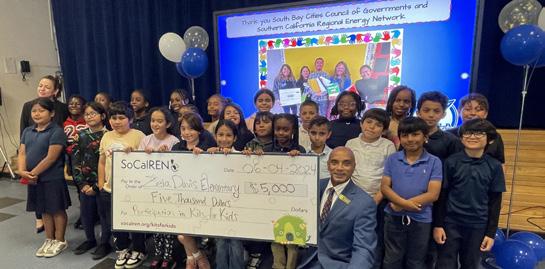
From
Perluss,
Students at Zela Davis Elementary School in Hawthorne pose with the earnings they received for helping their families become more energy-efficient at home. Front row, far right holding check: Hawthorne Council Member Alex Monteiro helps students celebrate.
Perspective
Los Angeles County Works to Ensure the Safety and Security of Ballots
By Dean C. Logan, Registrar-Recorder/County Clerk
As the upcoming election approaches, voters are rightfully concerned about the safety and security of their ballots. With questions like “Are the ballot boxes safe?” and “Can I trust vote by mail?” circulating, it’s crucial to reassure the public that Los Angeles County is dedicated to maintaining the accessibility, security and integrity of elections.
While voting in person at a Vote Center is always an option, here’s a comprehensive look at the measures to safeguard your ballot when voting by mail or using a Ballot Drop Box.
SAFETY OF BALLOT DROP BOXES
Ballot Drop Boxes have become a voter favorite, surpassing U.S. Postal Service returns in the 2020 general election and the recent presidential primary election. This overwhelming preference from voters
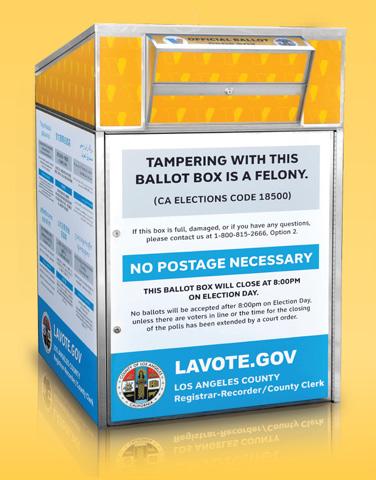
L.A. County’s Ballot Drop Boxes are available 29 days before and on election day. The status of ballots placed in drop boxes or mailed can be checked online through the county’s Vote by Mail Status Tool.
is a testament to the safety and security of these boxes. They’re not just convenient --they’re fortified. Constructed from highgrade materials and equipped with multiple locking mechanisms, they are designed to withstand tampering and vandalism.
Strategically placed in well-lit, high-traffic areas, these boxes are under the vigilant watch of trained personnel. They adhere to strict chain-of-custody protocols during ballot collection, ensuring that each vote is securely transported to counting centers.
TRUSTING VOTE BY MAIL
Vote by mail has earned the trust of millions of Americans, including those in L.A. County. Each ballot is assigned a unique barcode, allowing voters to track its journey from issuance to when it’s received and counted through California’s system.
Upon receipt, each mail-in ballot undergoes rigorous ballot preparation at our new Ballot Processing Center. At this state-of-the-art facility, dedicated county personnel process all mail-in ballots thoroughly, using advanced sorting and scanning technology including signature verification.
Every returned ballot undergoes signature verification by meticulously comparing it with those on file to confirm authenticity. This prevents fraudulent votes and ensures only valid ballots are counted, upholding the integrity of our electoral system.
SECURING THE LEGITIMACY OF THE VOTE
Before every election, we conduct logic and accuracy testing on our voting equipment to ensure everything functions correctly. Postelection, a 1% manual tally audit verifies the accuracy of machine counts, adding another layer of assurance.
Transparency is paramount. Our Public Observation Program invites the community to witness election-related activities firsthand, with live-streaming options available for those who cannot attend in person. This program
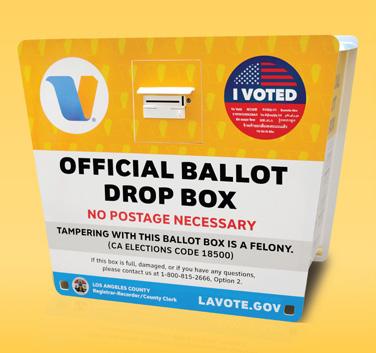
L.A.County works with law enforcement agencies, cities, local stakeholders and community-based organizations to monitor and safeguard all boxes.
underscores our dedication to an open and transparent process.
THE ROLE OF AI IN VOTING
While artificial intelligence (AI) is an increasingly important tool for enhancing election security, L.A. County is aware of its potential challenges and misuse. Our office is deploying various social media monitoring systems and strategies to identify and combat mis/disinformation. In addition to our monitoring efforts, we are conducting a comprehensive voter education and outreach program to ensure voters receive accurate and reliable information about the election process.
CONCLUSION
As we approach the election, rest assured that every possible step is being taken to protect the integrity of the voting process. With stringent measures to protect ballot boxes, rigorous verification processes for mail-in ballots and proactive strategies to combat mis/disinformation, voters can trust that their ballots are safe and their voices will be heard. •
For more information on voting security measures, please visit lavote.gov.
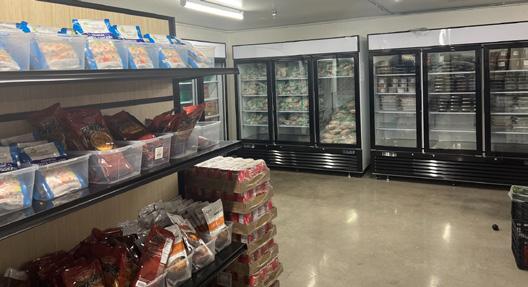
Removing Barriers to Success
Teddy’s Pantry offers a variety of fresh, frozen and refrigerated foods and prepackaged meals for CSUDH students and their families.
Toro CARE Program at Carson’s California State University, Dominguez Hills Provides Food and Other Basic Needs So Students Can Thrive
Simone Moss, a May graduate of California State University, Dominguez Hills (CSUDH), recalls when, as a student, she would contemplate spending $50 that she didn’t have in the bank to buy groceries so she could eat that week.
“I was in class taking a test, and I remember thinking, ‘OK, I don’t have anything to eat when I go home,’” she said. Despite living with her mom and working part time at Starbucks, it was challenging to make ends meet.
Through conversations she had on campus, she learned about Teddy’s Pantry—a school resource named after CSUDH’s mascot, Teddy. It provides healthy, fresh foods and hygiene items to students in need. She decided to check it out.
“They have soup, cereal, beans—the things that are good for making staple meals and the big quantities in order to last a good amount of time,” she said. “I would just scoop it into a bowl [from the large dish it was packaged in], heat it up and focus on studying for my test.”
A 2023 survey by the California Student Aid Commission revealed that two-thirds of college students were food insecure, while more than half were housing insecure. According to Tiffany Herbert, associate vice president of health and well-being at CSUDH, the challenge for students in meeting basic needs emerged within the California State University system just prior to and during the pandemic.
To make college more accessible for students, CSUDH created Toro CARE, a program designed to offer up to $1,000 per academic year to students experiencing hardships that impact academic, emotional or social progress. It opened a small food pantry in the library in 2022 and moved it to a larger location at the school’s College of Education building this spring due to demand.
Teddy’s Pantry offers a “Trader Joe’s” experience with freezer and refrigerated selections for students and their families. Items are donated by The Foodbank of Southern California, Student LunchBox and Sowing Seeds For Life.
“We have reimagined what we are doing with the pantry to offer a more nutrient-dense, healthy plate with the single-meal takeaways so that students can really utilize the pantry for their varying needs and their families,” said Candice Bangura, director of Toro CARE. The program also helps students apply for the USDA-funded nutrition program CalFresh and provides short-term housing resources, academic navigation, help connecting to health services and financial support.
With college under her belt, Moss is gearing up to launch her new career. She credits Toro CARE with helping her reach the undergraduate finish line. •
For more information visit csudh.edu/toro-care.
South Bay Watch is a quarterly bulletin by the South Bay Cities Council of Governments to inform local leaders of subregional progress and alert them to emerging issues.
Governing Board: Chair
Rodney Tanaka, Gardena 1st Vice Chair
Bernadette Suarez, Lawndale 2nd Vice Chair
Bill Uphoff, Lomita
Immediate Past Chair
Cedric Hicks, Carson
Members:
Carson, Los Angeles County, El Segundo, Gardena, Hawthorne, Hermosa Beach, Inglewood, Lawndale, Lomita, Los Angeles, Manhattan Beach, Palos Verdes Estates, Rancho Palos Verdes, Redondo Beach, Rolling Hills, Rolling Hills Estates, Torrance
SBCCOG Executive Director
Jacki Bacharach
Legal Counsel
Michael Jenkins, Best Best & Krieger LLP
Treasurer
Matthew Robinson, City Treasurer City of El Segundo
Editor
Colleen Farrell, Senior Project Manager, Communications
Contributor
Rosemary Lackow, Administrative Assistant Design
Vincent Rios Creative, Inc.
To subscribe to SBCCOG newsletters or view past editions, visit southbaycities.org/newsletter.
To view a schedule of SBCCOG meetings, visit southbaycities.org/calendar.
Website: southbaycities.org
Follow us: facebook.com/SBCCOG facebook.com/SBESC


@SouthBayCCOG @SBESC

@southbayccog
